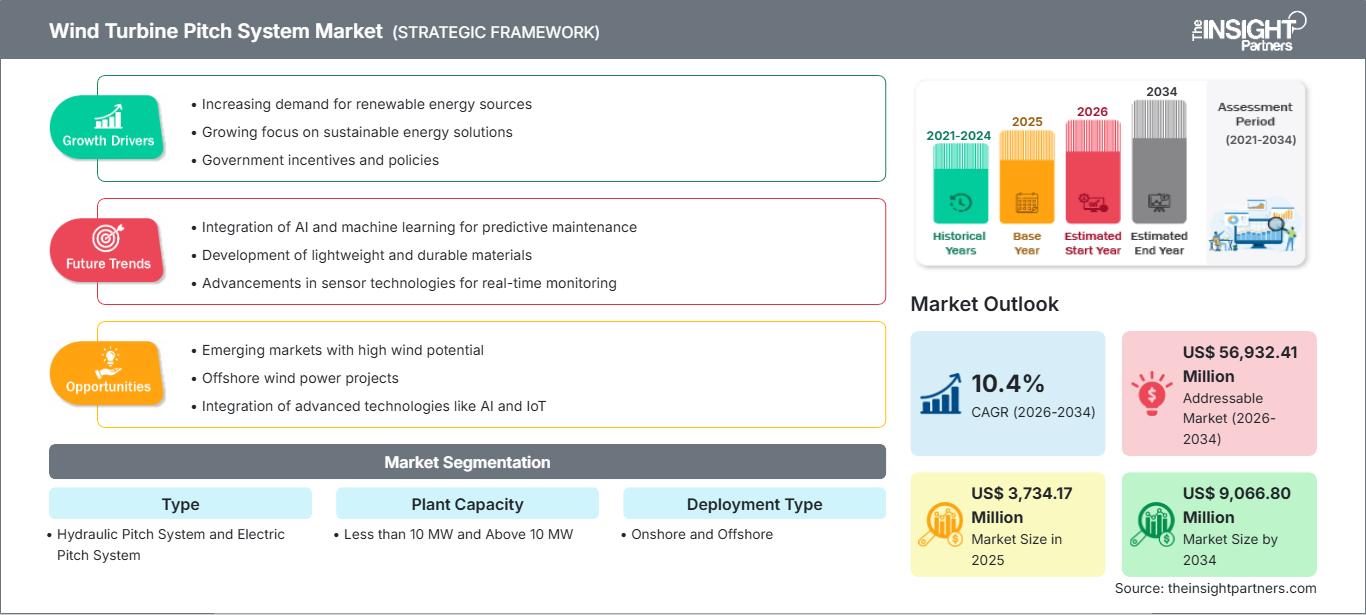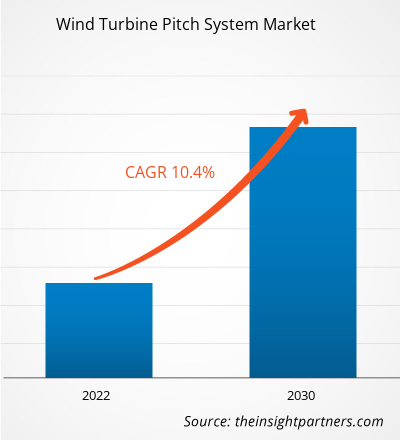Le marché des systèmes de réglage du pas des éoliennes, évalué à 3 734,17 millions de dollars américains en 2025, devrait atteindre 9 066,80 millions de dollars américains d’ici 2034, avec un taux de croissance annuel composé (TCAC) de 10,4 % sur la période 2026-2034. L’évolution constante du marché offre de nouvelles opportunités aux acteurs du secteur. Le contexte général témoigne d’une progression stable et d’un fort potentiel de croissance à long terme.
Aperçu du marché :
Le rapport sur le marché des systèmes de calage des pales d'éoliennes comprend une évaluation de la performance du marché dans différentes régions. Le système de calage des pales est un composant essentiel de l'éolienne. Il ajuste l'angle des pales en fonction de la direction et du flux du vent et contrôle la vitesse du rotor. La croissance démographique, l'urbanisation croissante et la demande énergétique grandissante alimentent le besoin en énergies alternatives pour répondre aux besoins énergétiques mondiaux. L'énergie éolienne est une source d'énergie renouvelable viable, capable de gérer cette demande croissante. L'accent mis sur la neutralité carbone et la réduction de la pollution environnementale stimule la demande en énergie éolienne, favorisant ainsi l'utilisation des systèmes de calage des pales d'éoliennes à l'échelle mondiale.
Personnalisez ce rapport selon vos besoins.
Vous bénéficierez d'une personnalisation gratuite de tous les rapports, y compris certaines parties de ce rapport, l'analyse par pays, le pack de données Excel, et vous profiterez également d'offres et de réductions exceptionnelles pour les start-ups et les universités.
Marché des systèmes de réglage du pas des éoliennes : Perspectives stratégiques

-
Découvrez les principales tendances du marché présentées dans ce rapport.Cet échantillon GRATUIT comprendra une analyse de données, allant des tendances du marché aux estimations et prévisions.
Facteurs de marché :
Initiatives gouvernementales pour stimuler la production d'énergie verte
Le marché des systèmes de réglage de l'inclinaison des éoliennes devrait connaître une forte croissance d'ici 2030, sous l'effet de l'urbanisation croissante, de la croissance démographique et de la nécessité accrue d'atteindre la neutralité carbone. Plusieurs pays d'Amérique du Nord, d'Europe et d'Asie-Pacifique investissent massivement dans la réduction de leur empreinte carbone. En 2022, les émissions totales du secteur énergétique chinois étaient cinq fois supérieures à celles de l'an 2000. La demande en énergies renouvelables a donc fortement augmenté, entraînant une multiplication des initiatives et des investissements publics en faveur du développement et de l'adoption de ces énergies. Par exemple, en 2023, le gouvernement américain a annoncé un investissement de 11 milliards de dollars dans la recherche et le développement dans le domaine des énergies propres. La même année, l'Allemagne a annoncé un plan d'investissement de 63 milliards de dollars dans les énergies vertes pour 2024, soit une augmentation de 60 % par rapport aux objectifs de 2023. Toujours en 2023, le ministère indien des Énergies nouvelles et renouvelables a lancé un nouveau processus d'appel d'offres pour les centrales éoliennes. Dans le cadre d'un nouveau mécanisme d'enchères, le gouvernement lancera des appels d'offres pour des projets éoliens d'une capacité de 8 GW par an, de 2023 à 2030, afin de dynamiser le secteur des énergies renouvelables. Lors de la Conférence des Nations Unies sur la biodiversité de 2023, le gouvernement chinois a annoncé son intention de construire des centrales éoliennes et solaires d'une capacité de 400 GW.
En 2023, les Émirats arabes unis ont inauguré leur premier parc éolien commercial de 104 MW. Ces initiatives et investissements gouvernementaux dynamisent le secteur de l'énergie éolienne et, par conséquent, le marché des systèmes de réglage de l'angle d'inclinaison des éoliennes. Ainsi, la volonté croissante des gouvernements de promouvoir les énergies renouvelables et de réduire les émissions de carbone est un facteur majeur de la croissance de ce marché. Les pays s'attachent principalement à accroître la part de sources d'énergie diversifiées et fiables afin de réduire leur dépendance aux énergies fossiles et de garantir un approvisionnement énergétique stable, essentiel à la croissance économique et à la sécurité énergétique nationale.
Analyse segmentaire :
Selon le type, le marché mondial des systèmes de réglage de l'orientation des éoliennes se divise en systèmes hydrauliques et systèmes électriques. La facilité d'application et de maintenance, ainsi que la disponibilité des pièces détachées, stimulent le marché des systèmes hydrauliques. Selon la capacité des installations, ce marché se segmente en deux catégories : moins de 10 MW et plus de 10 MW. L'accent mis sur la promotion des énergies renouvelables pour réduire les émissions de gaz à effet de serre et la demande croissante d'énergie propre constituent les principales tendances de ce marché. Selon le type de déploiement, le marché mondial des systèmes de réglage de l'orientation des éoliennes se divise en parcs éoliens terrestres et en mer. Des facteurs tels que des émissions de gaz plus faibles et des coûts de maintenance réduits par rapport aux parcs éoliens en mer devraient favoriser la croissance des parcs éoliens terrestres au cours de la période de prévision. La construction de parcs éoliens terrestres peut être réalisée en quelques mois, permettant ainsi aux exploitants de générer des revenus rapidement. Par ailleurs, les investissements publics et privés dans les énergies renouvelables, notamment dans l'éolien terrestre, ont dynamisé le marché des systèmes de réglage de l'orientation des éoliennes. La demande croissante d'électricité due à la croissance démographique et à l'industrialisation rapide stimule la demande en sources d'énergie renouvelables, ce qui devrait accélérer la croissance du marché des systèmes de calage variable des éoliennes entre 2022 et 2030.
Analyse régionale :
Géographiquement, le rapport sur le marché des systèmes de réglage de l'inclinaison des éoliennes couvre l'Amérique du Nord (États-Unis, Canada et Mexique), l'Europe (France, Italie, Allemagne, Royaume-Uni, Russie et reste de l'Europe), l'Asie-Pacifique (Australie, Inde, Chine, Japon, Corée du Sud et reste de l'Asie-Pacifique), le Moyen-Orient et l'Afrique (Arabie saoudite, Afrique du Sud, Égypte et reste du Moyen-Orient et de l'Afrique) et l'Amérique du Sud et centrale (Brésil, Argentine et reste de l'Amérique du Sud et centrale). Selon les estimations de The Insight Partners, en 2022, l'Asie-Pacifique détenait la plus grande part de marché des systèmes de réglage de l'inclinaison des éoliennes (51,1 %) et devrait enregistrer un TCAC de 10,6 % entre 2022 et 2030. L'industrialisation croissante et le nombre grandissant de parcs éoliens dans différents pays stimulent positivement le marché des systèmes de réglage de l'inclinaison des éoliennes en Asie-Pacifique. La Chine domine ce marché, suivie de l'Inde et de l'Australie. L'attention croissante portée à l'atténuation des émissions de carbone, à la réduction de la pollution environnementale et à la diminution de la dépendance aux combustibles fossiles devrait faciliter l'expansion du marché des systèmes de réglage de l'inclinaison des éoliennes en Asie-Pacifique.
L'Europe se classe au deuxième rang mondial en termes de nouvelles capacités éoliennes installées, avec plus de 19 GW en 2022. 87 % de ces nouvelles installations concernent l'éolien terrestre. La Suède, l'Allemagne et la Turquie dominent ce secteur. Le Royaume-Uni enregistre le plus grand nombre de nouvelles installations, notamment en mer.
L'Amérique du Nord regroupe des économies majeures telles que les États-Unis, le Canada et le Mexique. Le secteur éolien nord-américain devrait connaître une croissance remarquable grâce à une réglementation gouvernementale stricte, des politiques favorables et des investissements croissants dans les projets éoliens. En Amérique du Nord, la sensibilisation croissante des consommateurs aux objectifs de développement durable et au rôle des énergies renouvelables et de l'énergie éolienne devrait stimuler le nombre d'installations éoliennes dans la région, ce qui dynamise le marché des systèmes de réglage de l'angle des turbines.
Système de réglage du pas des éoliennes
Aperçu régional du marché des systèmes de réglage du pas des éoliennes
Les tendances régionales et les facteurs influençant le marché des systèmes de réglage du pas des éoliennes tout au long de la période prévisionnelle ont été analysés en détail par les analystes de The Insight Partners. Cette section aborde également les segments de marché et la répartition géographique des systèmes de réglage du pas des éoliennes en Amérique du Nord, en Europe, en Asie-Pacifique, au Moyen-Orient et en Afrique, ainsi qu'en Amérique du Sud et centrale.
Portée du rapport sur le marché des systèmes de réglage du pas des éoliennes
| Attribut du rapport | Détails |
|---|---|
| Taille du marché en 2025 | 3 734,17 millions de dollars américains |
| Taille du marché d'ici 2034 | 9 066,80 millions de dollars américains |
| TCAC mondial (2026 - 2034) | 10,4% |
| Données historiques | 2021-2024 |
| Période de prévision | 2026-2034 |
| Segments couverts |
Par type
|
| Régions et pays couverts |
Amérique du Nord
|
| Leaders du marché et profils d'entreprises clés |
|
Densité des acteurs du marché des systèmes de réglage du pas des éoliennes : comprendre son impact sur la dynamique commerciale
Le marché des systèmes de réglage du pas des éoliennes connaît une croissance rapide, portée par une demande croissante des utilisateurs finaux. Cette demande est alimentée par l'évolution des préférences des consommateurs, les progrès technologiques et une meilleure connaissance des avantages du produit. Face à cette demande grandissante, les entreprises diversifient leur offre, innovent pour répondre aux besoins des consommateurs et tirent parti des tendances émergentes, ce qui contribue à la croissance du marché.

- Obtenez un aperçu des principaux acteurs du marché des systèmes de réglage de l'inclinaison des éoliennes.
Analyse des joueurs clés :
Les contributions et les initiatives de marché d'acteurs clés tels que Siemens Gamesa Renewable Energy SA, Emerson, OAT GmbH, General Electric Company, Nidec Industrial Solutions, Vestas Wind Systems A/S, ABB Ltd., Parker Hannifin, Moog Inc., KEBA AG et KEB Automation KG influencent la croissance du marché des systèmes de réglage de l'angle d'hélice des éoliennes dans la région. Par ailleurs, de nombreux autres acteurs importants de ce marché ont été étudiés et analysés afin d'obtenir une vision globale du marché et de son écosystème.
Développements récents :
Les stratégies inorganiques et organiques sont largement adoptées par les entreprises sur les marchés mondiaux des systèmes de réglage de l'angle des éoliennes. D'après les communiqués de presse des entreprises, voici quelques développements récents des principaux acteurs :
Année |
Nouvelles |
Pays |
|
2023 |
Vestas Wind Systems A/S a décroché un contrat pour une éolienne de 186 MW auprès de la société énergétique nordique Ilmatar. |
Europe |
- Analyse historique (2 ans), année de base, prévision (7 ans) avec TCAC
- Analyse PEST et SWOT
- Taille du marché Valeur / Volume - Mondial, Régional, Pays
- Industrie et paysage concurrentiel
- Ensemble de données Excel
Rapports récents
Rapports connexes
Témoignages
Raison d'acheter
- Prise de décision éclairée
- Compréhension de la dynamique du marché
- Analyse concurrentielle
- Connaissances clients
- Prévisions de marché
- Atténuation des risques
- Planification stratégique
- Justification des investissements
- Identification des marchés émergents
- Amélioration des stratégies marketing
- Amélioration de l'efficacité opérationnelle
- Alignement sur les tendances réglementaires






















 Obtenez un échantillon gratuit pour - Marché des systèmes de pas d'éoliennes
Obtenez un échantillon gratuit pour - Marché des systèmes de pas d'éoliennes